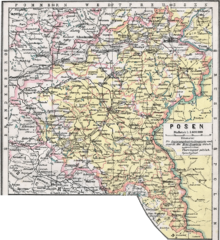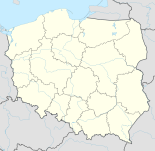Wysoka
| Wysoka | ||
|---|---|---|

|
|
|
| Basic data | ||
| State : | Poland | |
| Voivodeship : | Greater Poland | |
| Powiat : | Piła | |
| Area : | 4.82 km² | |
| Geographic location : | 53 ° 10 ′ N , 17 ° 6 ′ E | |
| Height : | 110 m npm | |
| Residents : | 2628 (June 30, 2019) |
|
| Postal code : | 89-320 | |
| Telephone code : | (+48) 67 | |
| License plate : | PP | |
| Gmina | ||
| Gminatype: | Urban and rural municipality | |
| Surface: | 123.04 km² | |
| Residents: | 6572 (Jun. 30, 2019) |
|
| Population density : | 53 inhabitants / km² | |
| Community number ( GUS ): | 3019093 | |
| Administration (as of 2007) | ||
| Mayor : | Marek Madej | |
| Address: | Plac Powstańców Wielkopolskich 21 89-320 Wysoka |
|
| Website : | gminawysoka.pl | |
Wysoka [ vɨˈsɔka ] ( German Wissek , 1942–1945 Weisseck ) is a town with 2,700 inhabitants in the powiat Pilski ( Schneidemühl district ) of the Polish Voivodeship of Greater Poland .
Geographical location
The city is located about 25 kilometers east of the city of Schneidemühl ( Piła ) and 60 kilometers west of the city of Bromberg ( Bydgoszcz ).
history

The village was first mentioned in 1260. In 1505, Wissek received Magdeburg town charter, which was granted in 1722 by landlady Apolinara von Tuczynska, born in 1722 after a large town fire, to which the documents fell victim. Smogolicka, was renewed.
During the first partition of Poland in 1772, Wissek came to Prussia . Then the city came into the possession of the Minister von Görne; after the confiscation of its property it belonged to the domain office, but was then given away again. In the 19th century, the town was owned by a Mr. Wiese.
From 1807 to 1815 the city was part of the Duchy of Warsaw . Wissek was returned to Prussia by the Congress of Vienna . From 1818 to the end of the First World War it belonged to the county Wirsitz in the administrative district of Bromberg of Posen .
By the middle of the 19th century, Wissek had three schools, one for each of the three denominations.
After the First World War , Wissek came under the provisions of the Versailles Treaty to the Second Polish Republic , where the city was part of the Polish powiat Wyrzysk until 1939. During the Second World War it was part of the new administrative district of Wirsitz .
Towards the end of the Second World War, the Red Army occupied the region in the spring of 1945 . Shortly thereafter, the city was handed over to the People's Republic of Poland . Insofar as the German residents had not fled, they were subsequently expelled by the local Polish administrative authorities .
Population numbers
- 1783: 266, mostly Poles, including 87 Protestant Germans
- 1788: 346
- 1816: 208, including 121 Catholics, 82 Evangelicals and five Jews
- 1837: 755
- 1843: 250
- 1850: 1,055, including 504 Catholics, 423 Evangelicals and 128 Jews
- 1858: 1.174
- 1861: 1.151
- 1885: 1,071, including 410 Protestants, 624 Catholics and 37 Jews
Town twinning
Wysoka has had a partnership with the German community of Jesberg in the Schwalm-Eder district since 2002 .
traffic
A narrow-gauge railway operated between Wysoka and Białośliwie .
sons and daughters of the town
- Johannes Jahn (1892–1976), art historian
- Karl-Gustav Sauberzweig (1899–1946), SS group leader
Gmina
The urban and rural community of Wysoka covers an area of 123 km² with 6,900 inhabitants. This includes the following 12 locations:
| Surname | German name (1815-1920) |
German name (1939-1945) |
|---|---|---|
| Bądecz | Bondecz 1873-1920 Collin |
Kollin |
| Czajcze | - Heinrichsfelde - Gut Czaycze |
Heinrichsfelde |
| Czajcze-Wybudowanie | Heinrichsfelde mining | ( to Heinrichsfelde ) |
| Eleanorka | Eleonorenhof | Eleonorenhof |
| Gmurowo | Orlandshof | Orlandshof |
| Jeziorki Kosztowskie | Schönsee | Schönsee |
| Kijaszkowo | Wolf Hagen | Wolf Hagen |
| Kostrzynek | Artificial rabbit | Küstrinchen |
| Młotkowo | Kaisersdorf | Kaisersdorf |
| Mościska | Moschütz | Moschütz |
| Mościska-Kolonia | Moschütz mining | ( to Moschütz ) |
| Nowa Rudna | New Ruhden | New Ruhden |
| Rudna | German Ruhden | Calm |
| Sędziniec | Richtershof | Richtershof |
| Starlings | Starlings 1917–1920 Starlings |
Starlings |
| Tłukomy | Tlukom 1873-1920 Groß Elsingen |
Great Elsingen |
| Wysoczka | Karlshof | Karlshof |
| Wysoka | Wissek |
1939–1942 Wissek 1942–1945 Weisseck |
| Wysoka Mała | Little Wissek |
1939–1942 Klein Wissek 1942–1945 Kleinweißeck |
| Wysoka Wielka | Wissek mining | ( to Wissek ) |
literature
- Johann Friedrich Goldbeck : Complete topography of the Kingdom of Prussia . Volume 2, Marienwerder 1789, part I, p. 98, no.2.)
- Heinrich Wuttke : City book of the country Posen. Codex diplomaticus: General history of the cities in the region of Poznan. Historical news from 149 individual cities . Leipzig 1864, pp. 467-468.
Web links
- Official website of the municipality (Polish)
- Information about the municipality (German, Polish, English)
- William Remus: Wissek (Wysoka), Kreis Wirsitz, West Prussia (2008) (English)
Footnotes
- ↑ a b population. Size and Structure by Territorial Division. As of June 30, 2019. Główny Urząd Statystyczny (GUS) (PDF files; 0.99 MiB), accessed December 24, 2019 .
- ↑ a b c d e f g h i j Wuttke (1864), pp. 467–468.
- ↑ Goldbeck (1789), Part I, p. 98, No. 2.)
- ^ Michael Rademacher: German administrative history from the unification of the empire in 1871 to the reunification in 1990. pos_wirsitz.html. (Online material for the dissertation, Osnabrück 2006).

